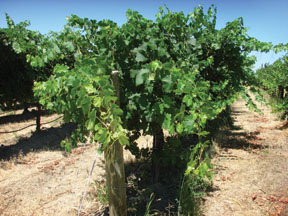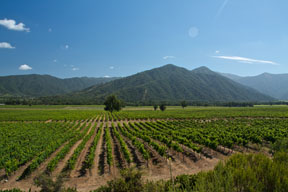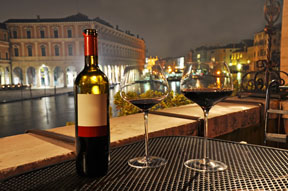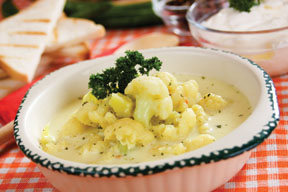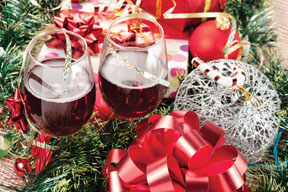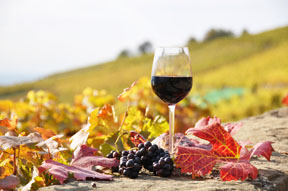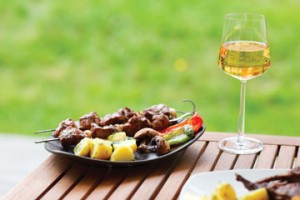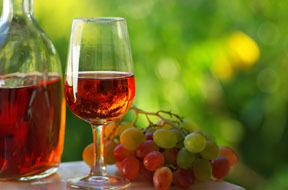Up the Pacific Coast – The Wines of Washington State
By Gordon Gilbert
California may be the undisputed king of wine production in the United States, but another serious contender has emerged thanks to its climatic conditions, huge swaths of land and ample sunlight throughout the growing season. Washington State ranks second in wine production in the U.S. and has managed to yield a wide array of grapes that don’t sacrifice quality for value.
Washington’s Cascade Mountains play a pivotal role in fostering the perfect climate for wine production with a rain shadow that shields their vineyards from the perpetual downpours of the Pacific Northwest. The rich soil and life giving irrigation of the Columbia River make this region a grape grower’s dream, while the high elevation brings additional summer sun that helps give the grapes extra time to ripen. Most of the mainstream varieties are found here with Italian and German varietals having made good headway in recent years. As more and more wineries pop up east of the Cascades, more nuance in terroir (the combination of location, soil and climate) is being discovered in the area, broadening the range of locales making a name for themselves.
The extra sun and absence of moisture in the rain shadow have proven ideal for Washington’s thick skinned red grapes, which in turn have produced robust red wines that have found great success among aficionados. Here are three amazing reds with great Pacific Northwest appeal:
Chateau St. Michelle Indian Wells; Columbia Valley ($14)
The perfect example of a great value Cabernet blend from an experienced winery that is known for benchmark quality. The blend is comprised of Cabernet, Syrah, Malbec and Cabernet Franc. Ripe and jammy in a new world style with deep, dark fruits that help hold the robust tannins in check. Strip steak accompanied by stuffed peppers makes for a perfect complement to this wine.
Kestrel Syrah; Yakima Valley ($20)
Crushingly good dark fruit flavors of blackberry, dark cherry and boysenberry syrup hang on the palate with this engaging Syrah. The fruitier aspects are subtly augmented with touches of spice, new oak and violas. This wine has the mass to tame roasted legs of lamb at any time of year.
Owen Roe Sinister Hand; Columbia Valley ($27)
This medium bodied blend of Grenache, Syrah, Mourvedre and Counoise mimics the wines of the Southern Rhone and serves as a great example of Washington’s offerings. The fruit is lush and black with plum at the forefront. Spices dominate the flavor profile with fresh cracked black pepper, anise, touches of cloves and cardamom. Pairs nicely with any grilled Mediterranean dish.
If your tastes swing more toward the white side of the fence, not to worry. Robust reds aren’t the only wines that have found a foothold in the Pacific Northwest scene. Cleanse your palate, give your glass a good rinse, then take advantage of this superb sampling of Washington whites.
Canoe Ridge Expedition Chardonnay; Horse Heaven Hills ($14)
For solid proof that Washington has a right to the silver medal for U.S. wine regions, look no further than this Chardonnay. Big and lush, this wine is geared to take on its big cousin to the south with tropical fruit, melon, vanilla, a creamy coating of butter and a hint of toffee. Grill up some chicken and serve it up on top of a nice Caesar salad for a dynamite food pairing.
Bridgman Riesling; Yakima Valley ($11)
Wine Spectator magazine bestowed a 92 point rating on this Riesling, cementing its place as one that true fans should not ignore. Bright and cheery in terms of acidity with an off-dry sweetness. Combinations of lime zest, tropical fruit and ripe peach fill every glass with sensational tastes and aromas. Grilled shrimp with chili flakes over a nice bed of greens might be in order here.
Wildhaven Pinot Gris; Columbia Valley ($10)
The humble Pinot Gris may be the most overlooked grape of the entire Pacific Northwest region. This medium bodied wine offers abundant sun drenched stone fruit with apricot and peach permeating a pleasant acidity. While it’s easy enough to enjoy on its own, it has an incredible range with multiple types of cuisine. Poultry, fish or other kinds of seafood should pair nicely.
While Napa may have the fanfare and Oregon carries its own big dose of notoriety, they certainly aren’t the only places on the Pacific Coast where you’ll find great wine. Washington has the perfect selection for any palate with a wide range of tastes to fit any wine lover’s bill.
South of the Equator – Wines of Chile
By Gordon Gilbert
Sandwiched between the cool currents of the South Pacific and the Andes Mountains, the South American nation of Chile boasts an extraordinary range of climates. From arid desert to alpine south, these varied regions play an integral role in the eclectic range of wines produced here.
A Well Weathered Selection
Chilean wine is produced almost exclusively in an area clustered around the capital city of Santiago, which benefits from river valleys flush with snowmelt coming off the Andes. Vineyards that sit closer to the ocean benefit from the cooling effects of maritime air, producing both outstanding white wines and Pinot Noir. As you head inland, the production of red wine increases, particularly in varietals that you might associate with Napa Valley or Bordeaux.
With such ranges of climate in this slender nation, the wines have an equally broad variety. Here are six examples that will allow you to explore the full spectrum just in time for grilling season.
Anakena Enco; Sauvignon Blanc; San Antonio Valley ($12)
All the classic elements of Sauvignon Blanc can be found in this wine from the coastal valley vineyards. Clean citrus, fresh lemongrass and wet stone yield an incredible wine with a palate activating acidity. This makes an ideal companion for a summer salad or shellfish.
Montes Alpha; Chardonnay; Rapel Valley ($13)
The Montes name carries a lot of weight in the Chilean wine world. Brash and full bodied, its notes of vanilla and butterscotch round out ripe melon and tropical fruits. If you’re about to throw some Chilean sea bass on the grill, this Chilean Chardonnay makes a good pairing.
Veranda; Pinot Noir; Bio Bio Valley ($18)
While Pinot Noir is known for being a more delicate red, this one offers the pronounced red fruit elements and medium body more akin to its Californian cousins. Hints of earth and spice are hidden under the vibrant raspberry, strawberry and red cherry that dominate the palate. Pairs well with antipasto or cheese and makes for a fantastic aperitif before moving on to more robust reds.
Casa Lapostolle; Merlot; Colchagua Valley ($14)
Casa Lapostolle commands serious premiums for their top flight wines, but fortunately their entry level options don’t suffer from a drop in quality. This medium bodied Merlot has smooth tannins with touches of dried red fruit, blueberry, mocha, spice and leather. A perfect all around crowd pleaser that pairs well with Mediterranean inspired dishes.
Porta; Cabernet Gran Reserva; Ancongua Valley ($16)
Grilled red meat will demand a bold, full bodied wine with powerful enough tannins to break down all that perfectly prepared protein. This wine fits the bill will a full complement of stewed black fruit, spice, cigar box and a lingering aroma that’s reminiscent of a chocolate factory.
Montes Purple Angel; Carmenere; 2010 ($60)
For those who want something that’s not one of the usual suspects, this remarkable wine is a personal favorite that earned a 93/100 point rating from Wine Spectator. Full bodied with lush tannins, the wine is black fruit dominant as the name infers, but there are touches of coffee and hints of minerality. Complex flavors linger on the palate long enough to win over even the most picky wine drinker. Decant and enjoy with a grilled T-bone or share with good friends.
Whatever your favorite grape, whatever the intricacies of your palate, Chilean wines offer a full spectrum of choices for any aficionado. Best of all, you don’t have to travel south of the equator to enjoy them. Sample just a few and you’ll want to revisit the wines of Chile many times over.
The Road Less Traveled – Unique Italian Wines
By Gordon Gilbert
Italy and wine have always been a match made in heaven, with a diverse selection that calls to mind distinctive aspects of this beautiful Mediterranean country. Chianti may remind us of a Tuscan villa situated on a lush green hill. Barolo may evoke thoughts of delicious white truffles from Albo. Pinot Grigio might conjure a warm spring day and a Florentine picnic. These are certainly the more prominent wines Italy has to offer, but what about its hidden treasures? Let’s take a moment to explore some of these lesser known gems from the heart of the Mediterranean.
Fatascia Almanera; Nero d’Avola; Sicily ($21)
We’ll make the island of Sicily our first stop. In the foothills of Mount Etna, we’ll find rich volcanic soils and the coating warmth of the sun, which combine to create the perfect environment for Nero d’Avola, a lush, full bodied wine that pairs well with a rich osso bucco.
Laden with ripe black fruit with touches of lily, violets and spice, the wine stands heavy on the palate with a juicy quality and offers low acidity and gentle tannins for a wine of this power.
Tenuta del Portale; Aglianico del Vulture Riserva; Basilicata ($19)
After crossing over from Messina to the toe of the Italian “boot,” we’ll breeze through Calabria on our way to Puglia or Campania. Nestled in between all three of these regions is Basilicata, which offers the Aglianco di Vultura, a wine that lovers of dry reds should not miss. It grips the palate like few others, a beautiful complement to grilled, gamey meats or heavy-duty cheeses.
Strong, intense flavors of stewed dark fruit are accented with anise, spice and a soft hint of pepper, along with an undercurrent of dusty earth. With a lengthy time aged in oak, this wine attacks the palate with high tannin levels that one would easily expect from a wine of the size.
Caleo; Primitivo Salento; Puglia ($10)
Moving up the road to Puglia, we’ll try to avoid the backpackers fighting to get to the ferry terminal at Brindisi as we search out yet another great red wine hailing from this region. The Primitivo grape is thought to be the origins of the now-classic Californian Zinfandel. For those that love the robust cherry notes of that wine, Primitivo will supply all they desire in a bottle.
Sweet red and black cherry, pepper and hints of spice personify this rich yet medium bodied wine from Puglia. The tannin levels are medium and the wine offers a short yet lush finish.
Cantina del Taburno; Fiano; Campania ($15)
Heading back towards Naples, we’ll cross through Campania and find ourselves in the town of Avellino, where we’ll be sure to discover the most elegant forms of the Fiano grape. This white wine is found throughout the region, with this offering sourced from the village of Taburno, and its flavor profile serves as a natural match for dishes containing pesto or roasted pine nuts.
A fuller bodied white, this wine has touches of white peaches, under-ripe apricot and hints of marzipan. The low acidity of the wine creates a lush feel on the palate with a medium finish.
Mauro Sebaste; Roero Arneis; Piedmont ($17)
Now we’ll hop aboard a ferry and travel past Capri, moving on to Genoa. Heading north into Piedmont, we’ll land right in the middle of Barolo country, where we’ll discover a medium bodied white wine called Arneis that is at once pleasant, crisp and clean. One of the lesser known white wines, Arneis will undoubtedly make an easy convert of any regular Pinot Grigio drinker.
This wine offers notes of Meyer lemon zest and elements of daffodils and daisies. Fresh and smooth, it’s got a long finish that makes for quite the refreshing aperitif on a warmer spring day.
Tamellini; Soave; Veneto ($16)
Moving on toward the canals of Venice, we’ll make a final stop near scenic Lake Garda. In the hills on the eastern shore is where we’ll find the Garganega grape, which produces Soave, a wine that’s clean and refreshing but has enough weight to pair well with grilled chicken or fish dishes.
Stacked with tropical fruit, ripened cantaloupe, creamed honey and yellow floral elements, the wine has a moderate acidity and gentle touches of wet river stone with a balanced, lush finish.
While Italy may always be known for its more popular grapes such as Sangiovese and Pinot Grigio, it’s a country that has so much more to offer wine aficionados. Explore some of the lesser known regions and you’re sure to find some hidden treasures to delight your palate.
Bowled Over – Winning Wines for Superb Soups
By Gordon Gilbert
Nothing warms up your soul on those cold winter nights like a hot bowl of soup, a traditional culinary delight that offers a limitless array of variations and flavors found in nearly every cultural corner of the world. With a dish that exemplifies that kind of global diversity, the wide range of available wine pairings can be equally vast and enriching. So pack your bags as we trek around the globe on a vino voyage to discover the perfect wine pairings for your favorite soups.
Cream of the Crop
Starting close to home, we commence our tour de soup with a classic cream based treat. Cauliflower cream soup offers a rich coating and distinctive nourishing quality that needs a wine capable of replicating those key characteristics. Thanks to the healthy dose of both cream and butter in the soup, white wines with a lactic texture are perfect. Here are two that will fit the bill:
Estancia Chardonnay; Monterey ($12): A full bodied white that complements the satisfying feel of the soup with a lush, creamy texture. The fruit profile has muted notes of honeydew, pineapple and baked apple that are subtle enough not to overwhelm the flavors of the soup.
Yalumba “Y” Viognier; Southeastern Australia ($11): Another full bodied white to work with the weight of the dish. This one carries more floral elements of honeysuckle, peach and a hint of sweetness geared to those who are looking for a slightly fruitier accompaniment.
Far East Flavors
Next up, we’ll cross the Pacific to Thailand, where we’ll find that a wide selection of wines can work in conjunction with the exotic tastes of Southeast Asia. As a general rule, when the spiciness of food increases, the sweetness of the wine should increase as well. Here are two options, a sweeter wine to accompany spicier fare and a more aromatic option for milder dishes:
Albrecht Gewurztraminer Reserve; Alsace, France ($20): Tropical fruits of this medium-bodied French wine dominate the flavor profile with touches of florals and a subtle spiciness. The sweetness beautifully offsets the spicier elements of the local cuisine.
Saget Chenin Blanc Vouvray; France ($12): Medium-bodied wine with a drier mouth feel than the Gewurztraminer. Orchard fruits, almonds and slight honey notes partner with the hints of curry and coconut that you will find in a variety of Thai dishes.
South of the Border
Residents of Mexico favor assorted forms of pozole soup to help warm up the winter. Though the soup’s composition changes from state to state, corn remains the heart of the dish. Varied regional additions include pork, chicken, chili peppers and more. To complement this range of flavors, we’ll head further south and dig up a couple of pozole pairings from New Zealand:
Matariki Sauvignon Blanc; Hawkes Bay, New Zealand ($15): This lighter delicate white from the north island has a clean texture to it that will not overpower the dish with remarkable citrus notes of lemon and grapefruit offset with a healthy shot of green pepper on the finish.
Crossings Pinot Noir; Marlborough, New Zealand ($17): Marlborough’s cool climate lends itself to growing great Pinot Noir. Medium-bodied with notes of red and black cherries, the tannins are not overbearing but remain sharp enough to complement the spiciness of the pozole.
Old World Offerings
To wrap up our journey, we’ll swing by the Mediterranean, where meatballs are often used to add weight, texture and flavor to soup. This kind of approach demands a heartier wine, but be careful to maintain the proper balance. A powerful Cabernet Sauvignon may be too heavy, while a Pinot Noir may run too light. Here are two wines that strike a happy Mediterranean medium:
Domaine de la Semelerie Chinon; France ($14): Made from Cabernet Franc, this French wine is lighter in weight and features higher acidity for a red wine, perfect for offsetting the meatballs. Fruit driven wines such as these are full of red currant, raspberries and a hint of roses.
Cortese Dolcetto d’Alba Trifolera; Italy ($16): This lighter-bodied red from the Piedmont region of Italy has notes of black cherry and violet. The tannins and dry nature of the wine break through the meatballs, while its lighter weight won’t take anything away from the broth.
The next time you sit down to enjoy a nice bowl of soup to help ward off that winter chill, remember that you can get more out of your dish than just broth and spices. Find the perfect wine to go with that bowl and your simple meal becomes a celebration of incredible flavor.
Naughty or Nice – Santa’s Wine List
By Gordon Gilbert
The holiday season is now in full swing, so it’s time to start making your list and checking it twice. Whether the names on your gift giving roll call have been on the good side or bad side, there is certainly a wine to be found in Santa’s bag of treats that’s perfect for each one of them.
Naughty
Capcanes Mas Donis Barica; Montsant, Spain; 2007 ($10)
This red wine hails from Catalonia in the north of Spain and has fantastic balance with plums, black cherry, red fruit and pepper. Predominantly Grenache (85%) with the remainder being Syrah, it’s a great value alternative to similar, more expensive propositions from nearby Priorat. Tannins and structure fall in the medium range, a great complement for burgers on the grill.
Indaba, Sauvignon Blanc; Western Cape, South Africa; 2011 ($8)
South Africa is another great destination for value oriented wines, particularly the Western Cape region, which is synonymous with good white wine. You’ll find a touch more body in their Sauvignon Blanc when compared to its New Zealand counterparts. Brisk refreshing acidity with fleshy notes of citrus and touches of green pepper match up nicely with a fresh green salad.
Not So Naughty
Molly Dooker, Shiraz, The Boxer; McLaren Vale, South Australia; 2010 ($19)
For those who love big, robust wines, look no further than this Shiraz from Molly Dooker (Australian slang for left-hander), with copious amounts of black fruit, including blackberry, blackcurrant and touches of Indian black pepper. Heavy tannins are offset by the lushness of warm fruit, making this weighty wine a nice pairing for an order of grilled lamb chops.
King Estate, Pinot Gris; Willamette Valley, Oregon; 2010 ($12)
While Oregon has gained much attention for its Pinot Noir, its cousin Pinot Gris is slowly emerging from the shadows. At times vastly superior to the abundant Italian Pinot Grigio that crowds most wine shelves, Oregon’s take is heavier than Italy’s and has a bracing acidity with notes of Anjou pear and Fuji apple. Smoked salmon with capers and dill is a culinary soul mate.
Nice
Chateau de Ferrand, St-Emilion Grand Cru; France; 2005 ($42)
A rich blend of Merlot, Cabernet Franc and Cabernet Sauvignon with touches of cedar and light truffle notes. Solid tannins create a wonderful lengthy sensation on the palate. The 2005 vintage is hailed as one of the greatest in 50 years, which is reflected in prices for many 2005 Bordeaux wines. Those with more of a taste for new world wines will discover a marvelous complexity and nuance. Savor this one with a dinner that takes hours to prepare and just as long to enjoy.
Ridge, Chardonnay, Mountain Estate; Santa Cruz, California; 2009 ($36)
Ridge has been producing wines since the late 1960s and took part in the famous “Judgment of Paris,” where American wines beat out French counterparts in a blind tasting as seen in the movie Bottle Shock. Ridge Chardonnay is the epitome of the classic Californian food wine with a rich, full intensity accompanied by touches of navel orange, cantaloupe and delicate caramel. All that exquisite fullness is offset by an acidity that adds to the complex nature of the wine.
That Special Someone
Nicolas Feuillatte Palmes D’or Brut Vintage; 1999 ($100)
Pour yourself a glass of this wine to experience a lovely, delicate quality with effervescence focused on the front palate. Lying behind this are rich notes of brioche, pear, hints of citrus, acacia and ginger. The unmistakable packaging supposedly represents the black pearls worn by an early love of Nicolas Feuillatte. You can’t ask for a more perfect wine to ring in the new year.
A great wine makes a perfect gift for just about any friend, no matter their disposition. Naughty or nice, there’s a perfect wine out there for them. If you’re lucky, they might even share their gift with you, a gesture that could move a former Grinch right to the top of the nice list for next year.
A Dash of Flavor – Spicing Up Your Wine Selection
By Gordon Gilbert
The Dutch are known for many things: beautiful tulip fields, windmills, fine art. But it’s their nearly three century long presence in southeast Asia and the famed Dutch East India Company that earned them credit for creating a new age of culinary delights. The exotic spices the Dutch brought home expanded the menus and palates of Europe and the new world. Fortunately, we don’t have to create our own shipping company to secure the treasures found in our spice racks.
From cloves and cinnamon to nutmeg and tellicherry, a vast array of flavors and sensations now grace our kitchens. Some spices provide huge blasts of intensity while others have long, lingering bouts of enjoyment, all of them offering a range of great enhancements to our daily menus. With such an extraordinary spectrum of tastes and sensations, it would impossible to limit ourselves to a single wine pairing. Rather, the more difficult task lies in finding a wine that enhances our chosen spice rather than detracts from it, resulting in a true complementary tasting experience.
Cinnamon
On the whole, cinnamon can be difficult to pair with, but Gewürztraminer is the best option here as well as with other heat driven spices such as cayenne or green curry powder. The name Gewürztraminer literally translates as “spiced” Traminer (a family of white grapes), so Albrecht Gewürztraminer Reserve (Alsace, France; $20) is a great place to start. The wine has an intense tropical feel with lychee dominating. Light floral notes give way to a wonderful coating texture and a sweetness that helps offset the more striking qualities of the cinnamon.
Nutmeg
Riesling is a great wine to pair with focused and more heat driven spices such as nutmeg, and you’ll find a good choice in the Geil Rheinhessen Spätlese (Rheinhessen, Germany; $18). Spätlese refers to late picked grapes, which increase the sugar levels of the wine. The sweetness acts as a natural foil to the heat generated by a wide assortment of spices, including nutmeg. The laser focused acidity of Riesling replicates the ability of nutmeg to concentrate on a certain portion of the palate. Flavors of this wine consist of pear, key lime zest and just a hint of slate.
Cloves
Cloves have a rich, fragrant persistence. Even with the most aromatic of wines, the intense power of this spice tends to win out, so a heavier selection is the better choice. A stout, tannic, yet medium bodied Zinfandel makes for a great combination with Indian curry or Jamaican jerk chicken, both of which make use of cloves. Calcareous Twisted Sisters Zinfandel (Paso Robles, California; $20) offers wonderful stewed plums with blackcurrant and pepper notes. The spiciness is concentrated in the mid-palate and has a medium finish with a hint of sweetness.
Tellicherry Black Pepper
The powerful heat of the Indian tellicherry black pepper makes a great addition to many grilled meats and a range of stews. With that in mind, the Catena Malbec 2009 (Mendoza, Argentina; $16) creates a harmonious combination with peppercorn and has the tannins to break through anything we put on the grill. Rich black fruit, touches of violet, hints of clove and a whisper of pepper help to create an enduring finish to match the long, drawn out heat of the peppercorn.
Fresh Herbs
While spices are important, we cannot overlook the significance of fresh herbs used in conjunction with them. Sauvignon Blanc, with its undeniable grassiness, certainly fits the bill here. Whether we are working with lemongrass, verbena, basil or lemon thyme, the Groth Sauvignon Blanc (Napa Valley, California; $14) helps add to their fresh qualities with citric fruits and a crisp, aromatic zippiness. While clean and racy, there’s still a hint of creaminess.
The right herbs and spices can help add lots of zest and punch to any culinary offering, but by pairing these accoutrements with the right wine, we can create delectable delights bursting with amazing flavors. Just the sort of pairing you need to spice up your kitchen and your wine rack!
Grilling with Class – Wines for Summer Barbecue
By Gordon Gilbert
Thanks to an abundance of sunshine throughout the year, there’s rarely a bad day for a barbecue in Las Vegas. Grilling outside can also help keep your oven and stove from overheating your house on those one hundred degree plus days. Whether you’re cooking with charcoal or gas, there’s always a perfect wine to complement whatever’s on the menu for your outdoor kitchen.
Beefing Up
We can’t talk about grilling season without mentioning steaks. Be it sirloin or ribeye, dry rub or marinade, any great cut of beef will require a big wine to break through the wonderfully rich textures, one that’s full of flavor to help work with a wide range of spices and preparation styles.
Two reliable varieties to fall back on are Zinfandel and Shiraz. Wines from these grapes are fruit forward, heavy bodied and just the ticket to mesh with a great steak. Here are two solid options:
D’Arenberg Laughing Magpie 2008 Shiraz ($28): McLaren Vale, Australia. Deep and richly colored. Blackcurrant dark cherry on the palate with touches of violet and black pepper. Fruit forward and full bodied, yet balanced with rich and powerful flavors that scream red meat.
Seghesio Zinfandel 2010 ($20): Sonoma County. Full bodied wine complete with heavy red fruits and touches of red berry. Herbaceous and spicy with a dry, lingering finish that provides ample heat on the back palate.
Wingin’ It
Next, we’ll tackle the more subtle staple of grilled chicken. With lighter augmentations such as lemon or herbs, California Chardonnay makes a great match. Heavier, more oaked wines blend well with citrus and herb treatments as well as the smoky qualities displayed in grilled poultry. Bolder, more flavorful preparations such as barbecue sauce call for red wines, but you don’t want to ignore the more gentle textures of the chicken underneath. Cotes-du-Rhone can help provide a beautiful symmetry that covers all the bases. Here are great options for both:
Mount Eden Chardonnay 2010 ($17): California. Deep yellow in color. Touches of banana and straw in the aroma. Cantaloupe, orange blossom and hints of stone fruit and pineapple come through on the palate. Creamy oak is offset with a touch of minerals.
Guigal Cotes-du-Rhone 2009 ($13): Rhone, France. Medium in terms of weight with black fruit and herbs on the nose and a touch of air dried tomatoes on the palate. This wine has a rich ruby color and a spicy finish perfect for a barbecue.
The Other White Meat
For something less traditional but equally tasty, grill up some chipotle pork. Spices provide a heat and flavor that work well for grilling; however, spice can make for a difficult pairing when it comes to wine. Garnacha (known as Grenache in France) is a great medium bodied red wine built for just such a situation. Grown in the western Mediterranean from Provence to Spain, this grape can handle the complexities of any spiced up dish. Another option worth considering is Oregon Pinot Noir, a light wine that matches well with the textural components of the pork.
Bodegas Artadi “Artazuri” Navarra Garnacha 2009 ($13): Navarra, Spain. Medium bodied wine with a bright, sharply focused nose and touches of pepper. The palate consists of spice, red berries and vine ripened tomatoes with a dry, gripping quality and a vibrant finish.
A to Z Pinot Noir 2009 ($16): Willamette Valley, Oregon. Another medium bodied option with fresh raspberries, wildberries and a touch of red cherry. Hints of violets and subtle spice with a light treatment of oak. A pleasant acidity on the finish follows the red fruit that dominates the initial tastes.
There’s no shortage of great wines to pair up with any kind of barbecue festivity. But whatever bottle you choose to enjoy while grilling, remember to save the heavier celebrating until after the coals are cool and the gas is off. No wine can dull the pain of a barbecue burn. Bon Appetit!
Vegetables & Vino – Farmer’s Market Wine Pairings
By Gordon Gilbert
In the last few years, Las Vegas has witnessed the birth of some wonderful farmer’s markets, including the marvelous Downtown 3rd (www.downtown3rd.com) and the acclaimed Bet on The Farm(www.betonthefarm.com), where you can find some of the best sustainable local vegetables and artisanal foods in town. Once a rare sight in our desert community, farmer’s markets now dot the Las Vegas valley, providing endless culinary options and a staggering array of fresh produce.
With this kind of variety, the bigger concern becomes which wine to pair with such fantastic delights. One solution might be to mimic the denizens of Europe, where farmer’s markets are a part of daily life, particularly along the Mediterranean. We’ll take a closer look at three of these markets and the amazing white wines their European customers use to complement the contents of their shopping baskets. Best of all, you can find all of these wines right here in Las Vegas.
Viva Italia!
Our first stop will be Genoa, located in the northwest of Italy on the Ligurian coastline. A short distance from the central Piazza de Ferrari, you’ll find the Mercato Orientale. While this market is renowned for some of the most phenomenal seafood on the Italian coast, you’ll also find handmade pasta, meats and a huge array of fruits and vegetables. Two white wines that pair extremely well with this wide assortment of fresh vegetables are Arneis and Gavi.
A native of Piedmont, just north of Liguria, Arneis is delicate but refined and medium bodied with notes of lemon, fresh flowers and minerals, a beautiful accompaniment to green vegetables. Mauro Sebaste Roero Arneis 2010 ($17) brings touches of citrus, white flowers and wet stone in a fabulous wine. Gavi, also from Piedmont, is more full bodied with tropical fruit florals and a touch of honey, not unlike a soft Viognier. We see this in Mauro Sebaste Gavi 2011 ($16) with notes of melon, pineapple and flowers. Thick vegetables such as eggplant, zucchini and squash are a good choice with Gavi, while its tropical notes favor berries and melons as well.
French Toast
Second stop: the Cours Saleya in Nice, France. Known for its famous flower market, you’ll also find a broad variety of fruits, vegetables and herbs. Striped awnings and wonderful scents from both the flora and fresh produce permeate the senses. White wines from nearby Provence and southern Rhône pair well with these choices and can be produced from a variety of grapes. Familiar varietals such as Viognier exist, but more unusual names such as Grenache Blanc and Rolle also play a part. White Côtes du Rhône derived from Viognier pairs well with tomatoes and eggplants while its aromatics pick up on fantastic Provençal herbs. Sample the Fleury Cotes du Rhone Blanc 2010 ($14) for a rich, fragrant wine with hints of orange, peach and apricot.
Vino de España
Mercat de La Boqueria, located on the La Rambla in Barcelona, is perhaps the best known farmer’s market on the planet. Covering an entire city block, this market offers a staggering ensemble of fresh produce, cured meats and seafood. Just outside Barcelona, you’ll find one of Spain’s most renowned areas for producing the sparkling wine known as Cava. A combination of local grapes Xarello, Macabeo and Parellada, Cava is a dry sparkling wine that pairs best with fresh berries from all across the board. For a classic Cava, you can’t go wrong with Segura Viudas Brut Heredad Reserva MV ($17), a dry and floral wine with a long brioche finish.
Just outside of Barcelona lies another region of note called Penedes. White grapes used here include Parellada, Riesling, Muscat, and Gewürztraminer, along with a combination of varietals. White wines of this region can be medium to full bodied with a wonderful dose of minerality. These characteristics make the wine a perfect combination with veggies such as zucchini, white asparagus and squash blossoms, but it can also be enjoyed with crisp apples and an assortment of cheeses. Gramona Penedes Gessami 2010 ($15) offers a combination of two Muscat varietals and Gewürztraminer in an aromatic, medium bodied wine that pairs well with most produce.
Fortunately, you won’t have to travel across the Atlantic to visit fabulous farmer’s markets. We can access beautiful berries, fantastic greens and aromatic herbs, along with the wines that pair with them, right here in our own neighborhoods. There’s no need to span the globe when you can enjoy all the great tastes of farmer’s market food and wine from the comfort of your own home.
Vegetables & Vino – Farmer’s Market Wine Pairings
Farmer’s Market Wine Pairings
By
Gordon Gilbert
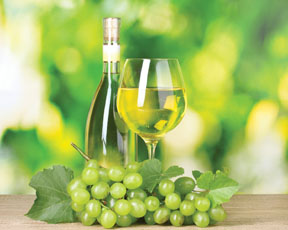
In the last few years, Las Vegas has witnessed the birth of some wonderful farmer’s markets, including the marvelous Downtown 3rd (www.downtown3rd.com) and the acclaimed Bet on The Farm(www.betonthefarm.com), where you can find some of the best sustainable local vegetables and artisanal foods in town. Once a rare sight in our desert community, farmer’s markets now dot the Las Vegas valley, providing endless culinary options and a staggering array of fresh produce.
With this kind of variety, the bigger concern becomes which wine to pair with such fantastic delights. One solution might be to mimic the denizens of Europe, where farmer’s markets are a part of daily life, particularly along the Mediterranean. We’ll take a closer look at three of these markets and the amazing white wines their European customers use to complement the contents of their shopping baskets. Best of all, you can find all of these wines right here in Las Vegas.
Viva Italia!
Our first stop will be Genoa, located in the northwest of Italy on the Ligurian coastline. A short distance from the central Piazza de Ferrari, you’ll find the Mercato Orientale. While this market is renowned for some of the most phenomenal seafood on the Italian coast, you’ll also find handmade pasta, meats and a huge array of fruits and vegetables. Two white wines that pair extremely well with this wide assortment of fresh vegetables are Arneis and Gavi.
A native of Piedmont, just north of Liguria, Arneis is delicate but refined and medium bodied with notes of lemon, fresh flowers and minerals, a beautiful accompaniment to green vegetables. Mauro Sebaste Roero Arneis 2010 ($17) brings touches of citrus, white flowers and wet stone in a fabulous wine. Gavi, also from Piedmont, is more full bodied with tropical fruit florals and a touch of honey, not unlike a soft Viognier. We see this in Mauro Sebaste Gavi 2011 ($16) with notes of melon, pineapple and flowers. Thick vegetables such as eggplant, zucchini and squash are a good choice with Gavi, while its tropical notes favor berries and melons as well.
French Toast
Second stop: the Cours Saleya in Nice, France. Known for its famous flower market, you’ll also find a broad variety of fruits, vegetables and herbs. Striped awnings and wonderful scents from both the flora and fresh produce permeate the senses. White wines from nearby Provence and southern Rhône pair well with these choices and can be produced from a variety of grapes. Familiar varietals such as Viognier exist, but more unusual names such as Grenache Blanc and Rolle also play a part. White Côtes du Rhône derived from Viognier pairs well with tomatoes and eggplants while its aromatics pick up on fantastic Provençal herbs. Sample the Fleury Cotes du Rhone Blanc 2010 ($14) for a rich, fragrant wine with hints of orange, peach and apricot.
Vino de España
Mercat de La Boqueria, located on the La Rambla in Barcelona, is perhaps the best known farmer’s market on the planet. Covering an entire city block, this market offers a staggering ensemble of fresh produce, cured meats and seafood. Just outside Barcelona, you’ll find one of Spain’s most renowned areas for producing the sparkling wine known as Cava. A combination of local grapes Xarello, Macabeo and Parellada, Cava is a dry sparkling wine that pairs best with fresh berries from all across the board. For a classic Cava, you can’t go wrong with Segura Viudas Brut Heredad Reserva MV ($17), a dry and floral wine with a long brioche finish.
Just outside of Barcelona lies another region of note called Penedes. White grapes used here include Parellada, Riesling, Muscat, and Gewürztraminer, along with a combination of varietals. White wines of this region can be medium to full bodied with a wonderful dose of minerality. These characteristics make the wine a perfect combination with veggies such as zucchini, white asparagus and squash blossoms, but it can also be enjoyed with crisp apples and an assortment of cheeses. Gramona Penedes Gessami 2010 ($15) offers a combination of two Muscat varietals and Gewürztraminer in an aromatic, medium bodied wine that pairs well with most produce.
Fortunately, you won’t have to travel across the Atlantic to visit fabulous farmer’s markets. We can access beautiful berries, fantastic greens and aromatic herbs, along with the wines that pair with them, right here in our own neighborhoods. There’s no need to span the globe when you can enjoy all the great tastes of farmer’s market food and wine from the comfort of your own home.
Reds and Rosés: Spring Wines from Provence
By Gordon Gilbert
When we mention the names Saint-Tropez, Monaco and Cannes, images of the French Riviera rush to mind, complete with mega yachts and film festival superstars. With all that extravagance, it’s hard to imagine the merit a simple bottle of wine could hold. But thankfully, there’s plenty of value to be found between Marseilles and Nice in the region of Provence, a locality flush with diverse and affordable wines that are as perfect for the warm climate of the Mediterranean as they are for the desert we call home.
A Rosé by Any Other Name…
Rosé is king in Provence, accounting for over 75% of its total wine production. While many tend to associate the salmon colored wines of Provence with the flood of white zinfandel on the market, nothing could be further from the truth. These wines are predominantly dry, crisp and cool, the perfect accompaniment to a nice lunch on the stern of your yacht – or, more realistically, a casual spring meal with friends by the pool here in Las Vegas. Generally served cool or chilled, rosés can be most refreshing on even the warmest of desert days.
Produced from red grapes, rosé is only kept in short contact with the grape skins, yielding a range of colors from pale pastel pink to Shirley Temple red. The wines are generally blended from Cinsault, Grenache Mouvedre and Syrah grapes, as well as more obscure local varietals, all of which benefit from the dry yet tempered maritime climate. With a wine of such uncompromising range, all things Mediterranean make for excellent food pairings, from tomato and mozzarella salads to feta cheese and olives or grilled lamb. Even without the addition of cuisine, rosés carry the most appeal as a refreshing respite from the afternoon heat.
For those who don’t own a yacht with its own zip code, here are three moderately priced rosés:
Domaine Rabiotte Aix en Provence Rosé 2010 ($12):
Clean notes of red berries, cherry and rose are heightened by this light-bodied wine. The tart dryness enhances salivation on the palate and makes for a perfect food wine or aperitif.
Domaine Ott Les Domaniers Provence Rosé 2010 ($20):
Peach and apricot stand tall in this medium bodied wine. Domaine Ott is known as one of the most recognized producers of rosé in Provence. Salad nicoise makes a perfect food pairing.
Domaine du Vieil Aven Tavel 2010 ($15):
From just outside of Provence, this Grenache based rosé from the southern Rhone is dry and medium bodied with strawberry and raspberry notes that dominate with a cutting minerality. Outstanding with light seafood pastas.
Red, Red Wine
To speak solely of rosé in Provence would do an injustice to the beautiful reds of this region. Dark, thick skinned grapes do best in the warm Mediterranean sun and can lead to wines of incredible complexity. Chateau Simone, Chateau Pradeaux and Domaine Tempier are three such superstars. Wines produced from these grapes command higher premiums but are certainly worth the price of admission with plums, cassis, hints of spice and herbs at the forefront. Serving these reds while cool but not very cold aids in suppressing the tannic nature of the grape varietals for a smoother taste. Any type of grilled meat usually makes for a harmonious food pairing, so you have an excuse to get back to the barbecue before the sweltering summer months kick in.
Two standout reds for those who require a little more color than pale pink include:
Fontanyl Cotes de Provence 2009 (Red; $13):
Deep, dark hearted fruit with elements of pepper and tarragon. Medium in weight on the palate with tannins that are perfect for engaging the succulent flavor of grilled meat.
Domaine Tempier Bandol 2009 (Red; $35)
An age worthy wine, full bodied yet restrained, made predominately from Mouvedre grapes with Grenache, Cinsault and a touch of Carignan. Powerful spices and cassis dominate.
Whether your tastes run to red or rosé, the wines of Provence are sure to provide a relaxing libation to help you feel refreshed before the summer sun returns. Pair a glass with some tasty barbecue, enjoy a sip at the pool or just share a bottle with friends for a smooth spring delight.
Tip from the Sommelier
The question of what temperature to serve wine has been largely debated. For those of us who keep their whites in a refrigerator and reds at room temperature, it’s good to follow the “half hour rule” to find that optimum. Remove whites and rosé from the fridge 30 to 40 minutes prior to serving, and put those reds into the fridge 30 to 40 minutes prior to serving. Bottoms up




